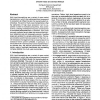Free Online Productivity Tools
i2Speak
i2Symbol
i2OCR
iTex2Img
iWeb2Print
iWeb2Shot
i2Type
iPdf2Split
iPdf2Merge
i2Bopomofo
i2Arabic
i2Style
i2Image
i2PDF
iLatex2Rtf
Sci2ools
VLDB
1991
ACM
1991
ACM
A Performance Evaluation of Multi-Level Transaction Management
Multi-level transactions are a variant of open nested transactions in which the subtransactions correspond to operations at different levels of a layered system architecture. The point of multi-level transactions is that the semantics of high-level operations can be exploited in order to increase concurrency. As a consequence, undoing a transaction requires compensation of completed subtransactions. In addition, multi-level recovery methods have to take into account that highlevel operations are not necessarily atomic if multiple pages are updated in a single subtransaction. This paper presents a performance evaluation of the multi-level transaction management that is implemented in the database kernel system DASDBS. In particular, it is shown that multi-level recovery can be implemented in an efficient way. We discuss performance measurements, using a synthetic benchmark for processing complex objects in a multi-user environment.
Database | Multi-level Recovery | Multi-level Recovery Methods | Multi-level Transaction | VLDB 1991 |
| Added | 27 Aug 2010 |
| Updated | 27 Aug 2010 |
| Type | Conference |
| Year | 1991 |
| Where | VLDB |
| Authors | Christof Hasse, Gerhard Weikum |
Comments (0)

